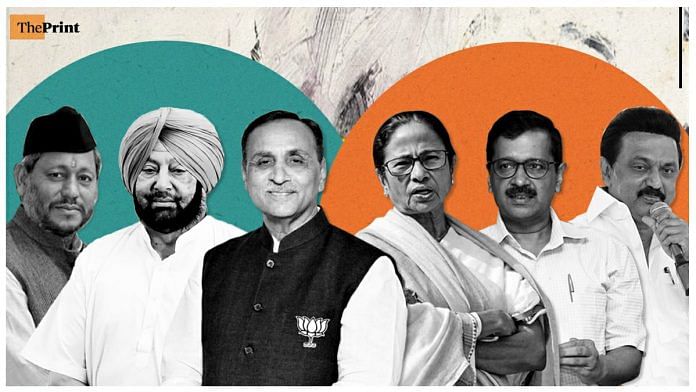India is now a tale of two kinds of chief ministers — the rising stars of regional parties who are firming their grip over politics with each election, and the unsteady state faces of the two big national parties who are prone to collapsing like a pack of cards when their high commands decide.
Coinciding with the rise and rise of chief ministers like Arvind Kejriwal, Mamata Banerjee and Jagan Mohan Reddy is the increasing weakening of CMs of the Congress and Bharatiya Janata Party (BJP), with their high commands shoving them away and finding more ‘beneficial’ replacements when needed.
From Uttarakhand’s Trivendra Singh Rawat and Karnataka’s B.S. Yediyurappa to Gujarat’s Vijay Rupani and now Punjab’s Amarinder Singh — the top leaderships of the national parties have had no qualms in sidelining and removing them when political compulsions or whims dictated. And, even though some like Yediyurappa and the Captain are stalwarts who hold clout, with the latter even managing to win the Congress elections braving the Narendra Modi wave.
Contrast this with the other set of CMs, the karta dhartas of regional parties, like Mamata Banerjee in West Bengal, Arvind Kejriwal in Delhi, Jagan Reddy in Andhra Pradesh, M.K. Stalin in Tamil Nadu. They’re slowly acquiring a national face and stature, serving as tough opposition to the Modi-led BJP and emerging as fierce challengers.
Also read: Picking Channi as Punjab CM has restored political canniness back into Congress game
The uncrowning
The big underlying question is whether a CM face ahead of elections is important, and whether the vote is for that face, the party or the party supremo like Modi or the Gandhis. There are no easy answers to these, and it is often more situation/state-specific than a general pattern.
But what is clear is that both the national parties — the Congress and BJP — seem to be more inclined towards the high command dictating terms, and CMs being largely used as props. The five-year trajectory national parties follow for states is populism, performance, and back to populism. Essentially, prop up a winnable CM face ahead of elections, look at performance once elected, and then just before the next elections, go back to populism and drop the CM if she/he is proving to be more of a burden than an asset.
The BJP removed three CMs in short succession — Trivendra Singh Rawat, Yediyurappa and Vijay Rupani. The Congress, meanwhile, has replaced Amarinder Singh in Punjab with Charanjit Singh Channi, and is grappling with a precarious leadership struggle in Rajasthan and Chhattisgarh.
While Rawat and Rupani may have been political lightweights, what is undeniable is how politically and electorally powerful Amarinder Singh and Yediyurappa have been. But the high commands of Congress and BJP hold the reins in their hands, rendering even the most powerful of the lot at their mercy.
To be sure, the Congress has always had a strong high command structure, where everybody except the Gandhis were powerless beyond a point. But to remove a CM who managed to win you one of the only three states you’re in power, and when you yourself are in no position to win votes, is quite something else. In the other two states of Rajasthan and Chhattisgarh, Ashok Gehlot and Bhupesh Baghel continue to sit on the edge of their seats, wondering when the top command might train its guns on them. After all, if the CM who led from the front and won the election could be toppled, how can those who were picked post-election amid a bitter power struggle sit confidently?
The BJP, meanwhile, has boasted of strong state leaders — from Modi himself to Shivraj Singh Chouhan, Raman Singh, Vasundhara Raje, among others, and now Yogi Adityanath — but seems to be now content letting its CMs play musical chairs. With three CMs gone, Haryana’s Manohar Khattar is perhaps spending some anxious days awaiting ‘the’ phone call. Shivraj Singh Chouhan owes his chief minister’s chair in this term to his party top leaders and has to toe their line, as does Karnataka’s Basavaraj Bommai.
The two BJP CMs who seem in control are Yogi Adityanath and Himanta Biswa Sarma, but Yogi has an election next year that will determine his fate and Sarma shouldn’t feel that confident either. After all, his predecessor Sarbananda Sonowal wasn’t picked as chief minister for second term, even though the BJP won the election with him as CM.
Also read: 8 of 20 CMs picked by Modi-Shah had to vacate seat. But it’s not a bad strategy
The sharp contrast
Most of the Congress and BJP CMs today are losing power and hold over their turf, if not electorally, then politically.
At the other end of the spectrum are CMs who are leaders of regional parties. Mamata Banerjee managed to keep the mighty BJP out of her state, and is successfully punching much, much above the weight of a CM from a small, regional party. Arvind Kejriwal is yet another leader who has managed to hold his turf tight, turning into a vehement and vocal opposition for Modi.
Jagan Mohan Reddy in Andhra Pradesh is doing spectacularly well, the recent local body polls serving as another reminder of that. In Tamil Nadu, Stalin has surprised many by his CM stint, with his first 100 days in power proving to be a success story.
Politically and electorally, the CMs from regional parties are becoming stronger, with their profiles growing, while those from national parties are pale shadows of themselves.
The divide is glaring and increasing as the Mamatas and Jagans emerge as leaders in their own right, while the Amarinders start receding to the peripheries.
Ruhi Tewari tweets @RuhiTewari. Views are personal.
(Edited by Neera Majumdar)



